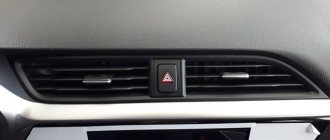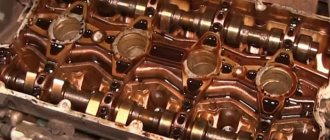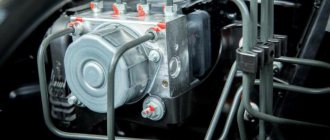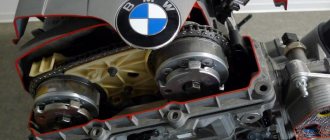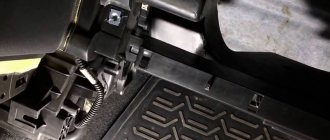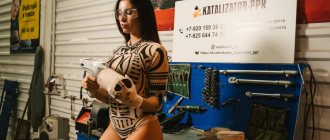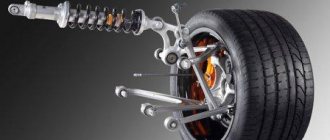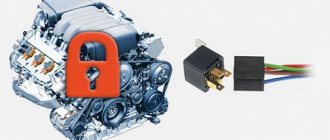The liquid cooling system of the power plant of any car ensures that the optimum temperature is maintained using liquid. Moving through the channels of the engine cooling jacket, the coolant washes the heated elements, taking away some of the heat from them, and then removes it to the environment through heat exchange processes in the radiator.
Purpose and location of the element
The coolant is unable to circulate through the radiator and engine water jacket on its own. To encourage it to move, the system uses a pumping device - a pump, whose impeller (impeller) is rotated by a belt drive from the crankshaft. Depending on the design of the vehicle, the pump is located in the following places:
- In front-wheel drive cars, the element is located on the right side of the engine (if viewed in the direction of travel). Since the pump is part of the timing belt drive, protected by a cover, it cannot be seen from the outside.
- On vehicles equipped with rear-wheel drive, the pump is located at the front of the power unit and is driven by the timing belt or alternator drive.
A pump built into the engine design is needed for effective cooling of the block and cylinder head by creating forced circulation. Thanks to it, the flow of antifreeze passes through 2 radiators - the main one and the cabin one, where it gives off the lion's share of the heat.
Impeller
It is installed on the other side of the axle. The impeller is a disk with wings applied to it (hence such a specific name). The part is made of aluminum. But recently, more and more often, cars come with plastic impellers. The part is rigidly fixed to the pump axis and rotates in proportion to the crankshaft. What is more reliable – plastic or aluminum? Many experts advise choosing a metal impeller. The best car pumps are made of aluminum, say motorists.
Purpose of pumps: fluid dependence
There are quite a few models of water pumps, but all devices are distinguished by one more characteristic - the ability to work without problems with a particular liquid medium.
- Clean or slightly polluted water. Such equipment has a chance to pump almost uncontaminated liquid without damage to working units. It may contain solid inclusions up to 0.5-0.8 mm in size.
- The water is moderately polluted. Pumps designed to work with it are more powerful. In this case, the partings are able to cope with pumping liquid, the size of solid particles of which is a maximum of 15 mm. The first example is fire motor pumps, which are used not only for their intended purpose, but also for transporting water over long distances.
- Heavily contaminated liquid. This pumping equipment is characterized by high performance, the ability to create pressure, the maximum of which is 35 m of water column. Such pumps easily cope with inclusions whose diameter does not exceed 25 mm.
The most serious problem is sewage wastewater, which requires “professionals”. Such pump pumps are called fecal pumps. Their purpose is to pump wastewater containing large, fibrous, insoluble inclusions. The difference between fecal aggregates and all previous types is the presence of a special device - a cutting mechanism. Its task is to grind the solid inorganic components of the liquid.
How to choose a suitable unit?
The operating principle of a water pump is not the only thing you need to pay attention to when choosing pumping equipment. Be sure to take into account other important factors.
- Pump pump performance. It shows how much liquid the unit is capable of pumping per unit of time. To buy the ideal device, you need to accurately calculate the amount of water used. Otherwise, the owners will have problems if the model turns out to be less powerful.
- Created pressure. First, the depth of the source is determined, then the length of the route to the water intake points is calculated. If there are vertical sections, then be sure to take them into account.
- Fuel consumption for autonomous devices. The efficiency of the device depends on this parameter. If fuel costs are excessive, then purchasing equipment is not practical.
The quality of the water supplied is another factor that influences the choice. When selecting any device, preference is always given to famous manufacturers, since only in this case can one hope for reliability, ease of use, long-term operation and functionality of the models. The equipment is not the last thing you need to know before purchasing.
You can find prices and popular equipment models here:
Since the choice of equipment depends on the tasks assigned to it, everything is decided by what the desired model is intended for. The following video will introduce you to one of the types of drainage pumps:
Was this article helpful? We want to improve. Thanks for your opinion!
Engine cooling system pump (pump): design, types and principle of operation, photo
To ensure the circulation of liquid in the cooling system of a car engine, a centrifugal pump, or pump, is used. It can have a mechanical or electrical drive type. If the pump is faulty, the entire cooling system will be inoperative, leading to engine overheating.
Centrifugal pump device
The pump is often installed in the front of a gasoline and diesel power unit. The solution is equipped with two types of drive. Mechanical drive is the most common. The mechanism is designed so that the force is transmitted from the crankshaft or camshaft of the power plant. A belt drive is used for this. The electric drive type is based on the use of an electric motor, which additionally has its own control system. The cooling system pump has a number of structural elements:
- frame;
- shaft;
- bearing;
- impeller (impeller);
- pump chamber seal;
- pad;
The coolant pump is a centrifugal type pump. During operation, the pump is capable of creating pressure in the cooling system at approximately 1 atmosphere. This pressure is quite enough for the boiling point of antifreeze in the system to move up by 20 degrees Celsius.
Types of well pumps
When thinking about which pump or pump is best suited for your site, you can, of course, review a lot of publications and even go to specialized forums where users discuss which pump is best to make with their own hands for a variety of conditions. Reviews from the owners will help you get your bearings a little in the huge variety of such products. However, you don’t have to do this, because in fact it is impossible to give an unambiguous answer to the question of which pump or pump is best to make with your own hands, because the choice depends on many factors: the diameter and depth of the well, the presence of impurities in the water, and the ability to connect to the electrical network. There are several types of well pumps that you can make yourself. Let's look at the main ones.
The body of such a pump is a metal cylinder. A piston moves inside it, connected to a “pumping” handle. A piece of pipe, a hydraulic cylinder body, or a liner from a diesel engine can be used as a body (cylinder). The piston can be made of various materials (plastic, wood, metal) - here everyone chooses the most convenient for the conditions of their site. The piston must be sealed with a rubber ring. The design is very similar to a hand pump for inflating a bicycle inner tube, only the water pump, whether manual or electric, is larger in size and capacity.
Layout of the surface pump.
The performance of the pump, be it manual or electric, purchased or made by yourself, depends on the valves, return and flow. Valves are holes located in the piston body and in the lower cylinder cover. When the piston moves to the bottom point, water passes through the valve into the space above the piston. When the piston moves upward, this water is forced into the outlet pipe. It must be metal or reinforced. It is unacceptable to use a purely rubber hose, because it will react to changes in pressure in the cylinder and constantly compress.
A deep-well electric pump is used if the water lies at a depth of more than 8-10 m. In its design, this pump completely repeats the model described above, but there are also some differences. The piston rod “walks” directly in the exhaust pipe, and it is installed not on the side of the cylinder, but on its top cover. In this case, the piston rod has an increased length, which is why it is best to make it yourself from a less heavy but reliable material.
Design and features
The pump is one of the main components of the internal combustion engine cooling system. It is a centrifugal type pump, including an impeller and a shaft with a pulley. The mechanism body can be cast iron or aluminum. The housing also has channels for discharging antifreeze to the impeller. There is a gasket between the internal combustion engine cylinder block and the housing, which prevents coolant leakage.
The main working element of the pump is the impeller. It creates fluid pressure in the system. The impeller is installed on the drive shaft. There is a drive pulley on the reverse side of the shaft.
The water pump is installed in the front of the engine, often near the thermostat. The car pump has an electric or mechanical drive. The latter is more common among automakers. This pump is driven by a belt from the crankshaft pulley. On machines with a timing chain this is a separate drive belt, but on belt machines it can be combined with the gas distribution system. The principle of operation is simple: the crankshaft pulley rotates the belt, and the latter drives the pump. The electric pump has a separate electric motor with a control system (similar pumps are often found on German cars). The principle of its operation is as follows. An electronic sensor reads the temperature of the antifreeze and gives a signal to turn on the pump only at +30°C and above. Next, the annular diaphragm is activated, and the liquid circulates throughout the system in full.
Frame
It is the supporting part of the pump. There is no need to explain what a hull is. It represents a “springboard” for placing all the components of the water pump. The exception is the pulley and the impeller itself. They are on the outside. The pump body itself is made of aluminum. In order to eliminate all kinds of leaks, a gasket is installed at the junction of the housing and the cylinder block.
It is disposable and cannot be reinstalled once removed. There is also a drain hole in the water pump housing. It prevents the accumulation of moisture and antifreeze at the bearing location.
Circles of circulation
Installation and installation of the oil pump VAZ 2108-2109-21099 The cooling system in the car has two circulation circles: large and small. The small one is considered the main one, since when the unit is started, coolant immediately begins to circulate through it. In the operation of the small circle, only the channels of the cylinder block, the pump, and the interior heating radiator are involved. Circulation takes place in a small circle until the internal combustion engine reaches normal operating temperature, after which the thermostat activates and opens the large circle. Thanks to this system, engine warm-up is significantly reduced, and in winter, the system does not so much cool the unit as maintain its normal temperature regime.
Small and large coolant circulation circles
The operation of the large circle involves a fan, a cooling radiator, inlet and outlet channels, a thermostat, an expansion barrel, as well as those elements that take part in the functioning of the small circle. The outer circle, also known as the large circle, begins to work when the coolant temperature reaches 80-90°C and ensures its cooling.
The principle of operation of the pump and its design
Cars have a fairly simple pump design. Its body simultaneously serves as a mounting flange. It is equipped with several holes through which the unit is fixed to the BC.
Due to the fact that the body is made of aluminum, it is possible to minimize the influence of corrosion processes, and the weight of the finished product is also reduced. The design also includes:
- the main shaft with rolling bearings is pressed into the central hole of the housing;
- at the cantilever end of the shaft there is a rigidly fixed plastic or aluminum impeller;
- the outer shaft shank is equipped with a pulley (grooved or gear models are used);
- The sealing gland helps prevent antifreeze leakage and ensure the tightness of the structure.
The pump flange can be screwed either directly to the block or through an adapter to ensure alignment of the belt drive without removing the impeller from the antifreeze flow. Manufacturers install a gasket under the flange.
Based on the device and method of fastening, the operating principle of the antifreeze pumping unit becomes clear. Rotation is transmitted to the shaft and then to the impeller via a belt drive. As the crankshaft speed increases, the impeller speed increases, which promotes intense circulation through the channels.
Manufacturers guarantee uninterrupted operation of the pump for 40-140 thousand kilometers. The resource depends on the brand and model of the vehicle. Domestic cars are located closer to the lower value of the interval.
Important! Certain brands of cars are equipped with pumps powered by a personal electric drive.
Autonomous electrical equipment for pumps is not widely used among cooling system designs. This is due to an additional increase in the cost of the finished product and a slight decrease in the degree of reliability.
Car water pump device
Its design is simplified as much as possible. Everything simple is brilliant and less likely to break. It consists of a shaft, which is supported in a housing by two bearings. An impeller is attached to the shaft inside the pump, which causes antifreeze to circulate in the system. It comes in metal or plastic. The first is more reliable, the second is cheaper.
An oil seal is located between the working chamber and the bearings. It prevents coolant from getting into the bearings and leaking out under the hood of the car. The body is made of aluminum or cast iron, which can withstand temperature changes and vibration. It consists of two parts. A rubber gasket is installed between them. Thanks to this design, it is possible to replace the pump without removing it from the engine housing.
On the opposite side of the shaft, on the outside, there is a drive pulley. Which is firmly fixed to the shaft and driven by attachment belts or timing belts (it all depends on the car model). For example, on a VAZ 2107 - an alternator belt, an Opel Cadet - a timing belt. Therefore, the speed of fluid circulation depends on the rotation speed of the engine crankshaft; the higher the speed, the faster the coolant moves through the system.
The weak link in the design is the oil seal and bearing. The first one begins to leak antifreeze, which, entering the working cavity of the bearings, washes out the lubricant from them. The result is increased noise, and then jamming of the pump. There are cases when bearings begin to “howl” before the seal wears out. This low quality of parts makes itself felt. The service life of the mechanism is from 60 to 100 thousand km. In some cases, it requires replacement at 30 thousand, and some specimens lasted 160 thousand km.
Which pump impeller is better?
Most modern pumps have a plastic impeller. Its advantages lie in its lower mass compared to metal, and therefore lower inertia. Accordingly, the engine needs to spend less energy to spin the impeller. Often, so-called turbo pumps have a plastic impeller. Moreover, they have a closed design.
However, plastic impellers also have disadvantages. One of them is that over time, under the influence of high temperatures of antifreeze, the shape of the blades changes, which leads to a deterioration in the efficiency of the impeller (that is, the entire pump). In addition, the blades can simply wear out over time or even fall off the rod and spin. This is especially true for inexpensive water pumps.
As for the iron impeller, its only drawback is that it has great inertia. That is, the engine spends more energy to spin it up, in particular at the time of start-up. But it has a long service life, practically does not wear out over time, and does not change the shape of the blades. In some cases, it is noted that if the pump is cheap/poor quality, then rust or large pockets of corrosion may form on the blades over time. Especially if low-quality antifreeze is used or ordinary water (with a high salt content) is used instead.
Therefore, which pump to choose is up to the car owner to decide. To be fair, it is worth noting that most modern foreign cars have a pump with a plastic impeller. However, they are made with high quality, and over time they do not wear off or change their shape.
When choosing a pump, you also need to pay attention to the height of the impeller. From general considerations, we can say that the smaller the gap between the block and the impeller itself, the better. The lower the impeller, the lower the performance, and vice versa. And if the performance is low, this will not only lead to problems with engine cooling (especially at high engine speeds), but also to problems in the operation of the interior heater.
Also, when choosing a pump, you should always pay attention to the seal and bearing. The first should provide reliable sealing, and the second should work smoothly at any speed and for as long as possible. To extend the service life of the oil seal, it is necessary to use high-quality antifreeze, which includes oil seal lubricant.
Most often, the pump body for passenger cars is made of aluminum. This is due to the fact that it is easier to make parts of complex shapes with complex technological requirements from this material. Water pumps for trucks are often made of cast iron, since they are designed for low speeds, but it is important to ensure a long service life of the device.
Pulley
The rotation speed of the shaft directly depends on the diameter of the pulley. The manufacturer selects the optimal sizes for a particular modification.
There are three types of pulleys:
- Toothed - driven by a timing belt.
- Belt - driven by a regular belt.
- Electromagnetic - a clutch that regulates the rotation speed of the pump using a magnet.
The latest modification does not require sealing with an oil seal, so this pump will never leak. The pulleys are rigidly attached to the axle using bolts or key connections.
Bearing
The most common designs include a double row sealed ball bearing or roller bearing. This element is lubricated with high temperature grease.
Stuffing box
The seal is responsible for the tightness of the pump. To improve the properties of the seal, antifreeze is used with the addition of lubricant. Most modern pumps are equipped with a ceramic seal, consisting of two elements similar to a flat spool.
THE MAGIC OF CANDLE COLOR
In addition to church candles, you can use ordinary candles to achieve your goals, but you should know some features. There is a huge variety of candles: in size, shape and design, as you can see by visiting a good candle store. In a magical sense, beeswax candles are ideal - because of the symbolism of the bee and because it is a natural product. Since each color has its own distinctive property, you will need to choose a candle for your need. Knowing the meaning of different candle colors makes it easier to achieve certain goals. For rituals, and in general, it is worth buying good candles, made of colored paraffin or wax. You should not take dousing candles; with them you will not be able to feel the energy. Proper use of the color of a candle allows in many cases to reduce one’s own work to creating an intention, and everything else is done “according to the program” with a burning candle. Magic matches for candle color:
White - Purity, purification, protection. Any goals
Black - Revenge, curses, damage, love spell at any cost, getting rid of negative emotions, contact with the dead Red - Love, happiness, improving health, driving out evil, improving fate. Passion and creativity.
Pink - Love, friendship, happiness Orange - Attracting sympathy, success. Work, career.
Yellow - Predictions, fortune telling, removing obstacles and everything that brings misfortune. Intelligence.
Green - Prosperity, material well-being, rebirth, good luck. Money, healing.
Blue - Development and strengthening of parapsychic capabilities Blue - Fighting fear, protection from otherworldly forces. Calmness, wisdom Violet - Strengthening fortitude, treatment of serious illnesses, magic. Spirituality.
Purple - Contact with otherworldly forces, achieving power, overcoming something.
Brown - Treatment of pets, all housing problems. Silver - Animism, animal powers
Location and purpose of the element
Cars most often have two cooling circuits:
- small,
- big.
Various elements included in the cooling system are also provided. Each of them performs its own function. Why a pump is needed is obvious to many experienced motorists, since it works to forcibly pump fluid in the cavities and channels designated for this purpose.
The impeller built into the pump body is responsible for pumping antifreeze. The rotation of this wheel is transmitted via a belt drive. The transmission pulleys are located on the pump shaft and on the output shank of the vehicle's crankshaft.
The water pump is located where the engineers placed it. In most models of modern cars, you can find the pump in the following areas:
- if you look in the direction of travel, then in cars with front-wheel drive, the pumping device is located on the right end of the cylinder block (since the pump is rigidly connected to the timing drive, it is located where the drive is protected by a cover),
- rear-wheel drive cars are equipped with a water pump fixed to the front wall of the cylinder block, and the rotation of the impeller is provided by a timing belt or from the generator drive.
The pump distills antifreeze through channels and two radiators, one of which serves to remove heat into the atmosphere, and the second is capable of transferring heat to the cabin. In this way, it is possible to quickly cool the power plant.
Signs of a pump malfunction
The simplicity of the water pump design provides it with excellent reliability and long service life. But malfunctions with this unit still occur, since the design uses elements that are the “weak” point of the pump. They are bearings and oil seal. During operation, bearings often wear out, which leads to the appearance of backlash. This immediately affects the seal tightness. But the rubber element itself can become damaged during operation.
Video: Signs of a pump malfunction. Choosing a VAZ pump. VAZ NIVA pump device
The main signs of pump wear:
- Coolant leakage from the water pump side.
- The appearance of extraneous noise when the motor is running.
- Visually noticeable play when the unit is running.
All these signs are caused by worn bearings and a damaged oil seal. There are other malfunctions that are much less common. Among them are damage to the impeller as a result of chemical processes occurring as a result of constant contact with antifreeze, the appearance of cracks in the housing, excessive wear of the working surfaces of the pulley or gear.
Note that the water pump is one of the components of the power plant that cannot be repaired. All components are seated into the body by pressing, so the unit is non-separable, and if signs of wear appear, the pump is simply replaced. In this case, the gasket must also be replaced. The only thing is that you can only change the pulley, and only if it is attached to the axle using a bolted connection.
Causes of problems
In general, according to statistics, pumps and pumps are designed for an 11-year service life - if the owners of a separate SMA double-check their pockets before washing their clothes and take out all the excess. At the same time, the clothes are turned inside out so that buttons, plaques and locks do not damage the drum, fall off or clog the pump.
Along with excess objects and loose accessories, dirt and scale pose a danger to the pump. Before washing, say, jeans that were splashed with splashes of mud on the highway from the puddles of a KamAZ truck with a 20-ton truck rushing past you, the pants should be dried and cleaned, the dirty scabs should be removed from them. Sand, often contained in dirt, settles in the pump and clogs the filter, and if it is nevertheless possible to squeeze it out of the filter membrane with powerful pressure, it will clog the drain hose and settle in the general sewer system. The impeller and “snail” suffer from layered clay - the pumping of wastewater noticeably worsens, and the load on the pump motor gradually increases.
Mechanics also do not last forever, so even if the user of the SMA did not violate the rules and complied with all the restrictions that make the unit’s operation safe and fast, sooner or later the motor will wear out and the pressure impeller will crack. Even the use of a stainless steel impeller and bearings will not save the washing machine owner from pump failure due to wear and tear from many years of time between failures.
Types of cooling system pumps
Types of cooling system pumps Coolant pumps used in the modern automotive industry do not have any fundamental design differences. But they can be divided depending on the type of drive, purpose and housing design. The pump can be driven in two ways:
- Mechanical - the pump shaft is connected via a belt drive to the crankshaft or camshaft of the engine. In this case, it is set in motion synchronously with the engine starting.
- Electric - in this scheme, the pump shaft is driven by an additional electric motor, the operation of which is controlled by the electronic engine control unit (ECU).
DIY washing machine pump repair
Why do you need a pump in a car?
Under heavy loads, the pump is protected by fuses that are located on the winding of the part and are switched off. When the temperature normalizes, the contacts are restored.
First you need to disconnect the pump from the cochlea. In general, there are two types of fastening: simply with screws and without screws (you only need to turn the pump counterclockwise). At this stage, you can find out whether the impeller rotates on the shaft. Normally, it should spin with small delays, so-called jumps. This is due to the action of a magnet rotating in a coil. If it is difficult to turn and there is no debris, then you will have to completely disassemble the part and see if it is possible to repair the washing machine pump impeller.
The motor housing has a latch on both sides that needs to be unhooked with a screwdriver. This is if your car has a collapsible motor, but there are non-separable types. At first glance it is impossible to make out, but if you know some of the nuances, you can.
A construction hair dryer will help by heating the long part of the part, the so-called shank, at a low temperature. After heating the shank, the crosspiece with the magnet is removed from the housing. Usually dirt accumulates on the magnet and in the place where it was pulled out. After cleaning, the magnet itself is removed. Next you will see the bearing, which is also cleaned and lubricated. After these procedures, the part is reassembled. There is a ring under the blades that should fit tightly into place. The seal may need to be replaced.
Bearing wear
Because of this, friction appears between the volute and the impeller, which causes problems and repairs of washing equipment pumps. The problem can be solved by replacing the bearings. In an emergency, when it is not possible to buy a new part, and washing cannot wait, only shortening the blade by no more than 2 mm will save you. This is done with a sharp knife.
After repair, the housing is installed in the coil and fixed. This concludes troubleshooting the pump on your own.
If you liked the article, please share it
Previously on the topic:
Share
Can the part be repaired?
The vast majority of cars are equipped with a non-repairable engine cooling pump. If desired, the car enthusiast can remove and disassemble it, but it is unlikely that it will be possible to change the oil seal and bearing, since these spare parts are not on sale. The exception is the classic Zhiguli models and a number of other car models for which repair kits are produced.
Reference. Spare parts of repair kits are not original and do not shine with quality. The service life of the pump after repair will be halved compared to the factory spare part.
It is customary to replace water pumps as an assembly. Moreover, the replacement itself is not very difficult - we cleaned the seat of the old gasket, applied sealant and screwed on the new pump. The most labor-intensive part of the procedure is disassembling the timing belt assembly with marking, removing pulleys and filling/draining the cooling system. If you do not have enough experience in car repairs, it is better to entrust the work to the service station technicians.
Popular makes and models
For domestic and imported cars, car dealerships sell different models of water pumps. Each of them has its own characteristics.
Manufacturers of water pumps for foreign cars
One of the most common manufacturers of car pumps is the Spanish company Dolz. By the way, Dolz has been producing technical devices for equipping vehicles since 1934. All models of water pumps are required to undergo certification, and therefore are considered reliable and high-quality in operation.
The product has a high price, but the build quality allows you to save on further operation
The Hepu company (Germany) manufactures water pumps for almost all brands of cars - from Porsche to Fiat. The concern's product line includes many models of pumps, and in the production of each product special attention is paid to the introduction of the most advanced technologies.
BGA is a UK manufacturer of pumps and other automotive components. The company is very strict about quality control of its products, so each pump lasts for many years.
Manufacturers of water pumps for Russian cars
The Belarusian enterprise Fenox produces cheap mechanisms of average quality. Each product has a factory passport and warranty.
The Russian company sells pumps for the domestic automobile industry complete with a sealing gasket. This part is easy to change. Products from this company can be purchased at almost any auto store.
Another Russian company Luzar specializes exclusively in the production of water pumps. The impeller is made of aluminum alloy, which ensures the lightness of the mechanism. In addition, the kit includes not only a seal, but also additional fasteners.
Luzar is one of the most popular manufacturers of water pumps in Russia
Thus, the car pump is the element on which high-quality engine cooling depends. It is worth paying attention to the choice of a new element and repairing the old one, if necessary.
Replacing the water pump of a Volkswagen Polo yourself: how to do it quickly and efficiently
Replacing the pump on a Daewoo Nexia: replacement procedure and recommendations for drivers
Car pump: everything is simple inside
The engine water pump itself is quite simple. Let's take, for example, the domestic auto industry, where pumps have a very similar design, regardless of brand and model. Typically this unit consists of the following spare parts:
- frame;
- shaft;
- impeller;
- drive pulley;
- stuffing box;
- bearings.
A shaft, the main element, is installed in a specially shaped housing. On one side, a drive pulley is attached to the shaft, which is in contact with the timing belt and receives rotational energy from it, and on the other, it has an impeller that circulates antifreeze throughout the system.
The oil seal deserves special attention. Its task is to prevent coolant from seeping into the cavities where the bearings are located. Since the oil seal tends to wear out, sooner or later antifreeze gets to the bearings and finds its way out of the pump, and we will talk about this later...
What is a pump in a car
Engineers know how to extract thermal energy from an internal combustion engine in several ways:
- air;
- liquid;
- combined.
Systems developed on the basis of air cooling are usually called open. They involve directed air flows that bypass the engine body from the outside. This design is becoming less and less common in modern cars, but is in demand in small motor vehicles.
Representatives of closed systems are liquid analogues. Heat is removed due to the circulation of antifreeze through the channels of the covering jacket of the cylinder block. The combined scheme involves the introduction of both air and liquid cooling for the car.
In the last two types of designs, a pump is a mandatory attribute; this is what a water pump is usually correctly called, as an integral part of the forced circulation of coolant in a car.
Important! Liquid-cooled systems are much quieter than their counterparts that use air to dissipate heat.
Frequency of pump replacement
Most automakers recommend replacing the cooling system water pump at least every 90 thousand kilometers. However, this frequency is not always constant and depends on the operating conditions and the quality of the pump itself.
Worn Lacetti timing belt
More often than not, the service life of the pump exceeds this value. There are symptoms that indicate malfunction or wear that may appear much earlier. Among them:
- Car engine overheating. It is necessary to monitor the indicators of the sensors.
- Loss of seal in the pump housing, leakage of coolant. Usually the leaks will be visible if you shine a flashlight under the hood.
- The smell of grease leaking from a damaged bearing. Not everyone can smell it, but many do.
- A characteristic sharp sound indicating a faulty bearing or impeller.
- If you do not know the time during which the old pump works, then you can focus on the above signs, and if they are present, replace them in time.
The process of natural wear and tear of the pump is accelerated by factors such as:
- sudden changes in temperature, extreme heat or cold;
- poor quality pump assembly;
- lack or excess of lubricant in the impeller bearings;
- filling the cooling system with low-quality coolant, which corrodes the working elements of the pump.
If signs of a malfunction are detected, you should not delay replacing the pump; in the long term, this can lead to expensive repairs to the car’s power unit.
Seals, axles, bearings
There is a steel axis inside the pump. Two bearings are installed on the latter, which ensure rotation. Typically the axle is made of high-strength steel. And the bearings themselves are of a closed type. Inside they contain lubricant for the entire service life. As a rule, it lasts for a long time. Typically, bearings last 200-250 thousand kilometers. Now about the seals. What is this element for?
It serves to seal the coolant with the bearings. It is unacceptable for antifreeze to come into contact with these elements. Otherwise they will be destroyed. The oil seal is a rubber element that is installed on the impeller side of the water pump.
Causes and consequences of water pump failure
Since the car pump is a fairly simple mechanism, it does not break down too often, especially with normal engine care. However, even the most reliable pump can fail. There may be several reasons for the breakdown, including:
- wear of device components, including aging of the oil seal;
- initially low quality pump;
- unprofessional repairs.
If the system remains sealed, but the pump does not initiate fluid circulation through it, this will lead to an increase in engine temperature, as indicated by the gauge on the dashboard. Driving for a short time in this mode will cause the radiator to boil or the engine to seize.
If a pump leak occurs, you need to take action to eliminate it as quickly as possible.
Another sign of a pump failure is an antifreeze leak in the area where it is installed. If the leak is not very severe, this is not so scary, since the liquid circulating in the system will still perform its functions normally, it just needs to be topped up regularly. But still, if such a breakdown is detected, it is best to eliminate it immediately, because leaks tend to increase in intensively used engines.
Basic faults and repairs
The pump is considered a simple mechanism in its design. Breakdowns and malfunctions are quite rare. Service center specialists identify only three reasons why the mechanism may fail:
Wear of parts and components (usually due to aging of the oil seal, the device stops functioning normally).
Initial defect of the water pump.
Poor quality repair (even a good part will not ensure fluid circulation if it was installed incorrectly).
The main malfunctions of any water pump can be considered wear of the seal, breakage of the impeller, jamming of the bearing or loss of tightness. The pump begins to leak and even vibrate, which affects the quality of engine cooling and ride comfort.
Typically, car owners seek the services of repair specialists. In some cases, it is advisable to replace worn elements - oil seal, impeller or reinforced cuff. In rare cases, it is necessary to change the drive pulley.
You will need to completely disassemble the device and replace all worn parts with new ones.
However, the procedure for disassembling the mechanism is quite simple: you can disassemble the mechanism yourself using a screwdriver and wrenches and replace the used parts with new ones from the repair kit.
Operating principle of the engine cooling pump
Location of the cooling system pump
The main task of the cooling system pump is to create excess pressure to ensure forced circulation of fluid in the circuits. On the practical side, this speeds up the process of heat exchange between engine components and coolant.
When the car engine starts, the pump drive transmits rotational motion to the impeller through a belt drive and shaft. At this moment, a vacuum is created at the inlet (suction pipe), which facilitates the absorption of liquid into the pump. The liquid is in a cooled state, as it comes from the radiator of the cooling system.
Entering the central part of the pump, the liquid moves along the impeller blades and, under the influence of centrifugal force, is forced through the outlet pipe into the jacket of the engine cooling system (to the cylinder head). Under the influence of high pressure, the coolant passes through the circuit through the main components and removes heat. After this, it returns to the radiator again, where it cools and is sucked in by the pump for a new cooling cycle.
Consequences of breakdown
A pump that has become unusable can cause a lot of trouble. The amount of damage depends on how the pump in the car is activated - from the timing belt or the generator drive. Emergency situations look like this:
- A leaky oil seal or gasket begins to leak. The level of antifreeze in the system decreases, which can lead to overheating of the engine if the problem is not noticed in time.
- Due to a broken bearing, the pump shaft jams. The jerk causes the drive belt to fly off or break.
- When the pump seal leaks, the rotating pulleys throw fluid in all directions. Wet belts slip and wear out faster.
Note. The root cause of an antifreeze leak is often a worn bearing, not a seal. The shaft with the pulley and impeller begins to dangle and warp under the pressure of the drive belt. Under such conditions, the oil seal is not able to hold the antifreeze, causing the water pump to leak liquid out.
The worst case scenario is a timing belt drive rupture due to bearing jamming. For many cars, this leads to expensive repairs to the power unit, since the piston heads hit the open valve plates and bend their tappets. In the best case, you will have to remove the cylinder head and change the valve group; in the worst case, you will have to throw away the broken pistons and a cylinder head cracked from the impact.
A broken alternator drive belt will not cause any damage, unless the power supply to the on-board network disappears and the battery begins to discharge. But in parallel, the engine will overheat, leading to accelerated wear of the cylinder-piston group.
If a failure occurs
We recommend that you monitor possible negative symptoms that appear when the car water pump is operating. Its breakdown carries great risks for the performance of the engine. The extent of the consequences is influenced by the installation area and the method of connecting the pump.
The list of potential problems includes factors:
- A failed shaft bearing can jam the rotation of the pump. Accordingly, the pulley mounted on the shank will stop rotating, and the drive belt will fly off or break.
- Problems with sealing occur due to a worn oil seal or gasket, as a result of which the coolant level decreases. A lack of antifreeze leads to overheating of the internal combustion engine.
- Leaking antifreeze from under the seal ends up on the rotating pulleys, which distribute coolant to surrounding objects, including belts. After getting wet, the belts slip and wear out faster.
Often the root cause of loss of tightness and a decrease in antifreeze level is a worn-out bearing, and not an oil seal. The main shaft dangles and warps due to the force of the drive belt on the pulley. This causes the seal to deform and become unable to hold antifreeze, causing a leak to occur.
The most negative development of events is the rupture of the timing belt due to bearing jamming. Most cars then require expensive engine repairs. This is due to the impact of the pistons on the caps of the open valves, which results in an instant bending of the latter.
After a belt failure, it is highly likely that the car will have to remove the cylinder head and also replace the valves. Worst case scenario, the pistons and potentially cracked cylinder head will need replacing.
In a structure where the generator drive belt falls off, significant damage does not occur quickly. Such a malfunction can be identified by possible symptoms:
- the on-board power supply system will switch to discharging the battery;
- the battery will begin to lose voltage;
- the motor begins to overheat.
An increase in temperature leads to rapid depletion of the cylinder-piston group.
